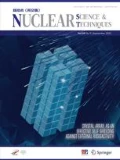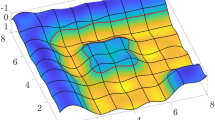Abstract
This article describes the transient models of the neutronics code VITAS that are used for solving time-dependent, pin-resolved neutron transport equations. VITAS uses the stiffness confinement method (SCM) for temporal discretization to transform the transient equation into the corresponding transient eigenvalue problem (TEVP). To solve the pin-resolved TEVP, VITAS uses a heterogeneous variational nodal method (VNM). The spatial flux is approximated at each Cartesian node using finite elements in the \(x{-}y\) plane and orthogonal polynomials along the z-axis. Angular discretization utilizes the even-parity integral approach at the nodes and spherical harmonic expansions at the interfaces. To further lower the computational cost, a predictor–corrector quasi-static SCM (PCQ-SCM) was developed. Within the VNM framework, computational models for the adjoint neutron flux and kinetic parameters are presented. The direct-SCM and PCQ-SCM were implemented in VITAS and verified using the two-dimensional (2D) and three-dimensional (3D) exercises on the OECD/NEA C5G7-TD benchmark. In the 2D and 3D problems, the discrepancy between the direct-SCM solver’s results and those reported by MPACT and PANDAS-MOC was under 0.97% and 1.57%, respectively. In addition, numerical studies comparing the PCQ-SCM solver to the direct-SCM solver demonstrated that the PCQ-SCM enabled substantially larger time steps, thereby reducing the computational cost 100-fold, without compromising numerical accuracy.


































Similar content being viewed by others
References
G. Zhong, K. Xu, Y. Lu et al., Study on application of DAG-OPENMC in fusion neutronics analysis. Nucl. Tech. 45(5), 050602 (2022). https://doi.org/10.11889/j.0253-3219.2022.hjs.45.050602 (in Chinese)
Z. Zeng, S. Chen, Y. Zhang et al., Neutronics experiments of dual functional lithium-lead blanket based on D-T fusion neutron source. Nucl. Tech. 45(4), 040601 (2022). https://doi.org/10.11889/j.0253-3219.2022.hjs.45.040601
X. Du, Y. Wang, Y. Zheng et al., The steady-state neutronic analysis and transient simulation of ADANES reactor design based on deterministic method. Nucl. Tech. 45(10), 100601 (2022). https://doi.org/10.11889/j.0253-3219.2022.hjs.45.100601
Q. Shen, Y. Wang, D. Jabaay et al., Transient analysis of C5G7-TD benchmark with MPACT. Ann. Nucl. Energy 125, 107–120 (2019). https://doi.org/10.1016/j.anucene.2018.10.049
A. Hsieh, G. Zhang, W.S. Yang, Consistent transport transient solvers of the high-fidelity transport code PROTEUS-MOC. Nucl. Sci. Eng. 194(7), 508–540 (2020). https://doi.org/10.1080/00295639.2020.1746619
S. Tao, Y. Xu, Neutron transport analysis of C5G7-TD benchmark with PANDAS-MOC. Ann. Nucl. Energy 169, 108966 (2022). https://doi.org/10.1016/j.anucene.2022.108966
B. Wang, Z. Liu, J. Chen et al., A modified predictor–corrector quasi-static method in NECP-X for reactor transient analysis based on the 2D/1D transport method. Prog. Nucl. Energy 108, 122–135 (2018). https://doi.org/10.1016/j.pnucene.2018.05.014
Z. Shen, Q. Sun, D. He et al., Comparison and verification of NECP-X and OpenMC using high-fidelity BEAVRS benchmark models. Nucl. Tech. 45(01), 010602 (2022). https://doi.org/10.11889/j.0253-3219.2022.hjs.45.010602. ((in Chinese))
Y. Wang, S. Schunert, J. Ortensi et al., Rattlesnake: a MOOSE-based multiphysics multischeme radiation transport application. Nucl. Technol. 207(7), 1047–1072 (2021). https://doi.org/10.1080/00295450.2020.1843348
T. Zhang, Z. Li, Variational nodal methods for neutron transport: 40 years in review. Nucl. Eng. Technol. 54(9), 3181–3204 (2022). https://doi.org/10.1016/j.net.2022.04.012
T. Zhang, Y. Wang, E.E. Lewis et al., A three-dimensional variational nodal method for pin-resolved neutron transport analysis of pressurized water reactors. Nucl. Sci. Eng. 188(2), 160–174 (2017). https://doi.org/10.1080/00295639.2017.1350002
T. Zhang, E.E. Lewis, M.A. Smith et al., A variational nodal approach to 2D/1D pin resolved neutron transport for pressurized water reactors. Nucl. Sci. Eng. 186(2), 120–133 (2017). https://doi.org/10.1080/00295639.2016.1273023
M.A. Smith, E.E. Lewis, E.R. Shemon, DIF3D-VARIANT 11.0: a decade of updates. https://doi.org/10.2172/1127298 (2017)
Y. Wang, H. Wu, Y. Li, Comparison of two three-dimensional heterogeneous variational nodal methods for PWR control rod cusping effect and pin-by-pin calculation. Prog. Nucl. Energy 101, 370–380 (2017). https://doi.org/10.1016/j.pnucene.2017.06.002
T. Zhang, W. Xiao, H. Yin et al., VITAS: a multi-purpose simulation code for the solution of neutron transport problems based on variational nodal methods. Ann. Nucl. Energy 178, 109335 (2022). https://doi.org/10.1016/j.anucene.2022.109335
F. He, X. Cai, W. Guo et al., The transient analysis of molten salt reactor reactivity insertion based on RELAP5/FLUENT coupled program. Nucl. Tech. 44(3), 030601 (2021). https://doi.org/10.11889/j.0253-3219.2021.hjs.44.030601. (in Chinese)
S. Dulla, E.H. Mund, P. Ravetto, The quasi-static method revisited. Prog. Nucl. Energy 50(8), 908–920 (2008). https://doi.org/10.1016/j.pnucene.2008.04.009
D. Caron, S. Dulla, P. Ravetto, New aspects in the implementation of the quasi-static method for the solution of neutron diffusion problems in the framework of a nodal method. Ann. Nucl. Energy 87, 34–48 (2016). https://doi.org/10.1016/j.anucene.2015.02.035
Y.-A. Chao, A. Attard, A resolution of the stiffness problem of reactor kinetics. Nucl. Sci. Eng. 90(1), 40–46 (1985). https://doi.org/10.13182/NSE85-A17429
S. Aoki, T. Suemura, J. Ogawa et al., The verification of 3 dimensional nodal kinetics code ANCK using transient benchmark problems. J. Nucl. Sci. Technol. 44(6), 862–868 (2007). https://doi.org/10.1080/18811248.2007.9711323
B.W. Park, H.G. Joo, Improved stiffness confinement method within the coarse mesh finite difference framework for efficient spatial kinetics calculation. Ann. Nucl. Energy 76, 200–208 (2015). https://doi.org/10.1016/j.anucene.2014.09.029
C. Tang, Application of stiffness confinement method in transient transport calculation. J. Nucl. Eng. Radiat. Sci. (2019). https://doi.org/10.1115/1.4044749
W. Xiao, Q. Sun, X. Liu et al., Application of stiffness confinement method within variational nodal method for solving time-dependent neutron transport equation. Comput. Phys. Commun. 279, 108450 (2022). https://doi.org/10.1016/j.cpc.2022.108450
E.E. Lewis, W.F. Miller, Computational Methods of Neutron Transport (Wiley, New York, 1993)
K.O. Ott, D.A. Meneley, Accuracy of the quasistatic treatment of spatial reactor kinetics. Nucl. Sci. Eng. 36(3), 402–411 (1969). https://doi.org/10.13182/NSE36-402
M. Kheradmand Saadi, A. Abbaspour, Effective point kinetic parameters calculation in Tehran research reactor using deterministic and probabilistic methods. Nucl. Sci. Technol. 28(12), 171 (2017). https://doi.org/10.1007/s41365-017-0323-7
K.F. Laurin-Kovitz, E.E. Lewis, Variational nodal transport perturbation theory. Nucl. Sci. Eng. 123(3), 369–380 (1996). https://doi.org/10.13182/NSE96-A24200
A. Zhu, Y. Xu, T. Downar, A multilevel quasi-static kinetics method for pin-resolved transport transient reactor analysis. Nucl. Sci. Eng. 182(4), 435–451 (2016). https://doi.org/10.13182/NSE15-39
F. Alcaro, S. Dulla, P. Ravetto, Implementation of the quasi-static method for neutron transport, in International Conference on Mathematics and Computational Methods Applied to Nuclear Science and Engineering (M &C 2011), Rio de Janeiro, RJ, Brazil, May 8–12 (2011)
W.M. Stacey, Nuclear Reactor Physics, 2nd edn. (Wiley-VCH, Weinheim, 2007), pp.603–604
J. Hou, K. Ivanov, V. Boyarinov et al., C5G7-TD benchmark for time-dependent heterogeneous neutron transport calculations, in International Conference on Mathematics and Computational Methods Applied to Nuclear Science and Engineering (M &C 2011), Jeju, Korea (2017)
J. Hou, K.N. Ivanov, V.F. Boyarinov et al., OECD/NEA benchmark for time-dependent neutron transport calculations without spatial homogenization. Nucl. Eng. Des. 317, 177–189 (2017). https://doi.org/10.1016/j.nucengdes.2017.02.008
C. Hao, J. Ma, X. Zhou et al., Development, verification and application of the uncertainty analysis platform CUSA. Ocean Eng. 261, 112160 (2022). https://doi.org/10.1016/j.oceaneng.2022.112160
Acknowledgements
We would like to thank Professor Yun-Lin Xu of Purdue University for providing the detailed C5G7-TD benchmark results data of the PANDAS-MOC.
Author information
Authors and Affiliations
Contributions
All authors contributed to the study conception and design. Material preparation, data collection, and analysis were performed by Wei Xiao. The first draft of the manuscript was written by Wei Xiao, and all authors commented on previous versions of the manuscript. All authors read and approved the final manuscript.
Corresponding author
Additional information
This research was supported by the National Natural Science Foundation of China (Nos. 12175138, U20B2011) and the Young Talent Project of the China National Nuclear Corporation.
Rights and permissions
Springer Nature or its licensor (e.g. a society or other partner) holds exclusive rights to this article under a publishing agreement with the author(s) or other rightsholder(s); author self-archiving of the accepted manuscript version of this article is solely governed by the terms of such publishing agreement and applicable law.
About this article
Cite this article
Xiao, W., Yin, H., Liu, XJ. et al. On the transient models of the VITAS code: applications to the C5G7-TD pin-resolved benchmark problem. NUCL SCI TECH 34, 20 (2023). https://doi.org/10.1007/s41365-023-01170-x
Received:
Revised:
Accepted:
Published:
DOI: https://doi.org/10.1007/s41365-023-01170-x




